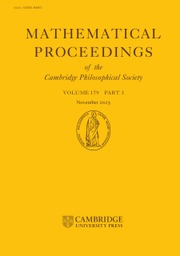No CrossRef data available.
Article contents
Number of solutions to a special type of unit equations in two unknowns, III
Published online by Cambridge University Press: 07 August 2025
Abstract
It is conjectured that for any fixed relatively prime positive integers a,b and c all greater than 1 there is at most one solution to the equation  $a^x+b^y=c^z$ in positive integers x, y and z, except for specific cases. We develop the methods in our previous work which rely on a variety from Baker’s theory and thoroughly study the conjecture for cases where c is small relative to a or b. Using restrictions derived from the hypothesis that there is more than one solution to the equation, we obtain a number of finiteness results on the conjecture. In particular, we find some, presumably infinitely many, new values of c with the property that for each such c the conjecture holds true except for only finitely many pairs of a and b. Most importantly we prove that if
$a^x+b^y=c^z$ in positive integers x, y and z, except for specific cases. We develop the methods in our previous work which rely on a variety from Baker’s theory and thoroughly study the conjecture for cases where c is small relative to a or b. Using restrictions derived from the hypothesis that there is more than one solution to the equation, we obtain a number of finiteness results on the conjecture. In particular, we find some, presumably infinitely many, new values of c with the property that for each such c the conjecture holds true except for only finitely many pairs of a and b. Most importantly we prove that if  $c=13$ then the equation has at most one solution, except for
$c=13$ then the equation has at most one solution, except for  $(a,b)=(3,10)$ or (10,3) each of which gives exactly two solutions. Further, our study with the help of the Schmidt Subspace Theorem among others more, brings strong contributions to the study of Pillai’s type Diophantine equations, notably a general and satisfactory result on a well-known conjecture of M. Bennett on the equation
$(a,b)=(3,10)$ or (10,3) each of which gives exactly two solutions. Further, our study with the help of the Schmidt Subspace Theorem among others more, brings strong contributions to the study of Pillai’s type Diophantine equations, notably a general and satisfactory result on a well-known conjecture of M. Bennett on the equation  $a^x-b^y=c$ for any fixed positive integers a,b and c with both a and b greater than 1. Some conditional results are presented under the abc-conjecture as well.
$a^x-b^y=c$ for any fixed positive integers a,b and c with both a and b greater than 1. Some conditional results are presented under the abc-conjecture as well.
Information
- Type
- Research Article
- Information
- Mathematical Proceedings of the Cambridge Philosophical Society , Volume 179 , Issue 3 , November 2025 , pp. 737 - 784
- Copyright
- © The Author(s), 2025. Published by Cambridge University Press on behalf of Cambridge Philosophical Society
Footnotes
Dedicated to Professor Masaaki Amou on the occasion of his retirement from Gunma University.
Supported by JSPS KAKENHI (No. 20K03553).
Supported by the NKFIH grants 150284 and ANN130909. The research was supported in part by the University of Debrecen Program for Scientific Publication.

